What is brake judder?
Most drivers experience brake judder at some point in their motoring lives. This juddering can range from the mild to the extreme.
It occurs when there are issues within the braking system that cause irregularities in the braking process and can be felt through the steering wheel, brake pedal - and perhaps the entire cabin.
Is brake judder dangerous?
While not an immediate threat, brake judder signals potential issues within the braking system that can compromise safety. The vibrations during braking may reduce control, particularly in emergencies, and prolonged exposure can accelerate wear on brake pads, leading to costly repairs.
Prompt attention by a professional is essential to maintain optimal braking performance and ensure safety on the road.

What causes brake judder?
Here we run through some of the most common causes for brake judder. Unless you are a skilled motoring mechanic, the best course of action is to take your car to the garage:
Disc issues
Disc thickness variation
One of the key causes of car juddering is warped or unevenly worn brake discs. Brake discs should be of the same thickness all around. Juddering will occur if they are not even.
Disc thickness variation (DTV) can cause the disc to make uneven contact with the brake pads, resulting in vibrations. Regular disc inspection and proper bedding-in of new discs can help prevent this.
Holding the brake pedal down when the brakes are overheatingcan cause pad material to weld into the discs, resulting in DTV. In this case your mechanic can sand off the pad 'imprint'.
Extreme disc overheating & distortion
If excessive and regular heat is applied to disc brakes, they can overheat, resulting in irregular contact - and juddering. However, this is likely a problem faced by rally drivers - or those who try to drive like them! Blue spots on the disc suggest overheating. In this case, brake pads should be replaced. Poor quality brake pads can overheat quickly, causing them to warp.
Dirt/rust on disc
If dirt or rust has built up on the disc, it makes contact poor. This is remedied by dismantling the disc and cleaning both surfaces.
Excessive tightening torque
If the position screws on the brake pad have been tightened too much, juddering can occur. In this case, the brake discs should be replaced but the position screws should not be tightened too much.
Distorted hub
This is less common, but can happen. Once the disc is fitted, a dial gauge should be used to check for disc run-out. It should be re-fitted if it’s not within tolerance. Hub maintenance is needed if there is still run-out.
Calliper problems
A sticking or seized brake calliper can cause uneven pressure on the brake pads, leading to juddering when braking. Dirt, rust, or worn-out components can cause callipers to malfunction, so regular maintenance is crucial to avoid this issue.
Pad issues
Low-quality or unevenly worn brake pads can cause car juddering. Overheated or warped pads can also contribute to brake judder, especially if the pad material has become distorted due to excessive heat.
Alignment and fitting
Misaligned brake components, such as incorrectly fitted alloy wheels, can also result in juddering when accelerating or braking. This can be caused by improper fitting, missing spacers, or even dirt between the hub and wheel. A professional check can identify and correct alignment issues.
Many alloy wheels are of the "one size fits all" variety. With the same wheel type being used for all kinds of different hubs and sizes, spigot wheel location spacers tend to be used by installers. A damaged/lost spacer can mean an incorrectly centred wheel. Your garage can fix this by measuring the run-out, and modifying as appropriate. However, the wheel may need to be changed.
Suspension problems
Faulty suspension components, such as worn-out shock absorbers or struts, can exacerbate car juddering during braking. Suspension issues cause uneven contact between the tyres and the road, resulting in vibration.
Keeping the suspension in good condition can minimise this risk.
Wheel and tyre issues
Damaged or unbalanced wheels and tyres can cause vibrations that feel like brake judder. Tyre wear, unbalanced wheels, or bent rims can all contribute to the sensation of juddering.
Ensuring proper tyre maintenance and wheel balancing is essential.
Mechanical issues:
Faults in other mechanical components, such as driveshafts or steering linkages, can lead to juddering when accelerating or braking. These issues may not be immediately apparent but can cause significant vibrations if left unaddressed.
Driver behaviour
Hard or aggressive braking, particularly with new discs, can lead to brake judder. Avoiding heavy braking for the first 100-150 miles of driving after new brake components are fitted helps prevent uneven wear.
Frequently Asked Questions
Yes, brake judder can be a sign of underlying issues with your braking system. While it may not pose an immediate danger, it can reduce control and increase wear on components, leading to costly repairs if not addressed promptly.
You can usually feel car juddering through the steering wheel, brake pedal, or even the entire cabin.
The judder is most noticeable when braking but can also occur while accelerating or cruising.
While some causes of brake judder can be remedied with basic mechanical skills, such as cleaning dirt from the brake disc, most issues require professional attention.
It's always best to consult a qualified mechanic.
To prevent car juddering, ensure that your brakes are properly fitted, avoid hard braking with new discs, and keep your braking system well-maintained.
Regular checks by a mechanic can help spot potential issues early.
The costs can vary depending on the cause of the brake judder. Simple fixes, such as cleaning the brake disc, may cost little, while more complex repairs, like replacing warped discs or faulty calipers, can be more expensive. Always consult with your mechanic for a detailed estimate.




